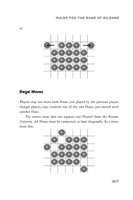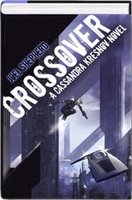 It's now been about five months since Pyr published my first novel Infoquake. It seems as good a time as any to sit back and take stock of my promotional efforts. What worked, what didn't work, what should I have done more of, what should I have done less of?
It's now been about five months since Pyr published my first novel Infoquake. It seems as good a time as any to sit back and take stock of my promotional efforts. What worked, what didn't work, what should I have done more of, what should I have done less of?When I started to make a list of all the promotional efforts I've made in the past year, I started to feel — well, a little embarrassed. To an outsider, it must look like I do nothing all day but come up with ways to move copies of Infoquake. The "Infoquakes Cereal" pic here is meant to be a joke, but honestly, sometimes it feels like I've tried everything but a sugary cereal for kids.
(Quick aside: Have you ever noticed that when companies say their cereal is "part of this nutritious breakfast," the cereal box is always sitting next to... a complete nutritious breakfast?)
Here, then, are the promotional efforts I did that I think were well worth doing:
- Designed and programmed a website for the book and bought several related domain names (infoquake.net, jump225.com, multireal.net, geosynchron.net)
- Wrote several original background articles on the world of Infoquake exclusively for the website
- Started a blog about eight months before the release of the book and began consciously trying to write about topics that I hoped would garner me an audience
- Joined the group blogs DeepGenre (thanks to Kate Elliott and Katharine Kerr) and SFNovelists (thanks to Tobias Buckell)
- Attended and got on the programming at a number of science fiction conventions (ReaderCon, WorldCon, Capclave, PhilCon, and upcoming Balticon and Penguicon)
- Hosted a five-book gimmicky giveaway contest on my blog that received a fair bit of attention
- Posted all nine drafts of the first chapter of Infoquake on my website
- Encouraged friends and family members to send e-mails to their contact lists recommending that they check out Infoquake
- Doggedly hunted down every interview opportunity I could find, and ended up getting about seven or eight interviews on sites like Barnes & Noble Explorations, John Scalzi's By the Way blog, the Agony Column, SFFWorld, and Suite101.com
- Created a MySpace profile and spent a couple weeks aggressively seeking friends with an interest in science fiction (1,698 friends to date!)
- Created a mailing list for the book and added just about everyone I knew to it, then sent out once- or twice-a-month mailings on book news and events
- Made a conscious effort to make friends in the science fiction industry, mostly just because it's nice to have more friends (although the Machiavellian in me notes that several of these friends have had some very nice things to say about Infoquake on their blogs and such)
I also did a number of promotional efforts that may have had some positive impact, but it's hard to tell:
- Designed and printed 1,000 four-color Infoquake business cards through VistaPrint.com and passed them out liberally to anyone and everyone
- Recorded the first handful of chapters on audio using my laptop, an old microphone, and free Audacity software, then posted these as a podcast on my website
- Created and gave away approximately 350 promotional Infoquake CDs at cons and readings, including all of the sample chapters and audio files
- Started an Amazon blog that basically just cross-posts the Infoquake-related blog entries from my main WordPress blog, and spent some time tracking down Amazon Friends
- Gave away two signed copies of Infoquake to the Save Apex Digest raffle organized by the radiant Mary Robinette Kowal
- Convinced a friend (Josef K. Foley) to do some original artwork for the Infoquake website
- Did a handful of readings and signings at chain bookstores, which had rather disappointing turnouts, despite considerable publicity (listing in the Washington Post literary calendar, front-of-the-store displays, emails and invites sent to everyone in creation)
- Held two book parties for immediate family and friends on what turned out to be two very inconvenient dates for book parties
- Took a nice, official-looking author photo, only to decide I didn't like it nearly as much as the spur-of-the-moment photo my wife took outside a club in Boston in 2002
- Read and made comments on two drafts of an Infoquake screenplay, which has been in front of a few big Hollywood players (though I'm not holding my breath)
- Made a conscious effort to participate in the blogosphere by commenting on other people's blogs
- Managed to get in touch with about a dozen authors and important people to ask for advance praise ("blurbs"), including an Obvious Legendary Hard SF Novelist, two Bestselling High-Tech Journalists, and a Business Legend With a Name So Big That Yes, Your Mother Has Probably Heard of Him — and only got a response from one person, the terrific Kate Elliott, who provided the gracious blurb you see on the praise page
Of course, there were also a number of things I tried to promote my book that have had seemingly no impact or fell flat altogether:
- Started a bulletin board-like Yahoo Group to try to encourage author/reader (or reader/reader) dialogue about the book
- Started a reading group program to encourage people to buy Infoquake in bulk and discuss it in their book clubs
- Tried my hand at writing short stories to get my name out there in the SF magazines, only to discover that finishing a short story is even more difficult for me than finishing a novel
- Created a LiveJournal that just mirrors the copy from my WordPress blog
- Contacted a dozen well-known legal/political bloggers known to be partial to science fiction and tried to get them to review the book; all said they'd take a look at the book, but none of them ever responded to my follow-up emails
- Sent a couple of free press releases out through PRWeb to try and spur some news coverage
- Tried unsuccessfully to persuade my publisher to sell advertising in the book (about which see my blog post Should Novelists Sell Advertisements?)
- Spent waaaay too much time trolling Google, Technorati, Amazon, Yahoo, Icerocket, and other websites to see who's talking about the book, what they're saying, how they're reviewing it, etc.
So now that you've gone through these lists of all the sh** I've done to promote Infoquake and shaken your head in amazement/befuddlement at my persistence/foolishness, what lessons have I learned? What wisdom do I have to impart to other authors about how to promote their books?
1. You don't necessarily need to spend a lot of money. Almost everything on the "useful effort" list above is a cheap or free enterprise. Conventions, of course, can be expensive — but surely you can do what I did, which is to attend cons where you can stay with relatives or friends and use frequent fliers/hotel points. Designing and programming a website can also be expensive if you don't know what you're doing — but it's perfectly acceptable to use free WordPress software and a free WordPress template instead of hiring a designer/programmer like me.
2. Play to your strengths. My strengths (luckily) are web consulting and online marketing. As I've discovered, I'm a mediocre public speaker and not exactly a champion debater. I don't have the world's biggest Rolodex. But I've managed to find some areas that fit my comfort zone where I could excel.
3. Recognize that the most important aspects of book promotion are the ones you have little or no control over. Sure, spending time doing an interview with a science fiction fan site might get your name out there and sell 10 or 20 or 100 or 300 books. But the buyer at Borders or Barnes & Noble can give you thousands and thousands of book sales if he/she has enough confidence in the book to place a big order. The reverse, unfortunately, is also true.
4. Nobody knows when you fail... I did some research on discussion groups and ended up settling on Yahoo! Groups for an author forum. I created the forum, publicized it in half a dozen places, and nobody cared. So? I took down the link, I shrugged my shoulders, I moved on. People in the publishing biz might be able to track down your BookScan numbers and see how and where (and if) your book is selling, but nobody else is going to bother.
5. ...But let everybody know when you succeed. Emphasize the positive. Spread the good word. Tell your friends. Brag about it on your blog.
6. You, the author, are the only one who really gets to decide if you succeeded or not. Today I got a note on MySpace from a reader saying this: "Don't think I'm blowing smoke up your hindparts when I say that Infoquake is easily one of the best books I've ever read.... The depth and detail of this new world rank right up there with Neal Stephenson's Diamond Age." It's comments like that that make me sit back and think, y'know, I don't care if I sell another copy of the book. I've done what I set out to do.
Okay, not really. Buy more. Please.
--David Louis Edelman









